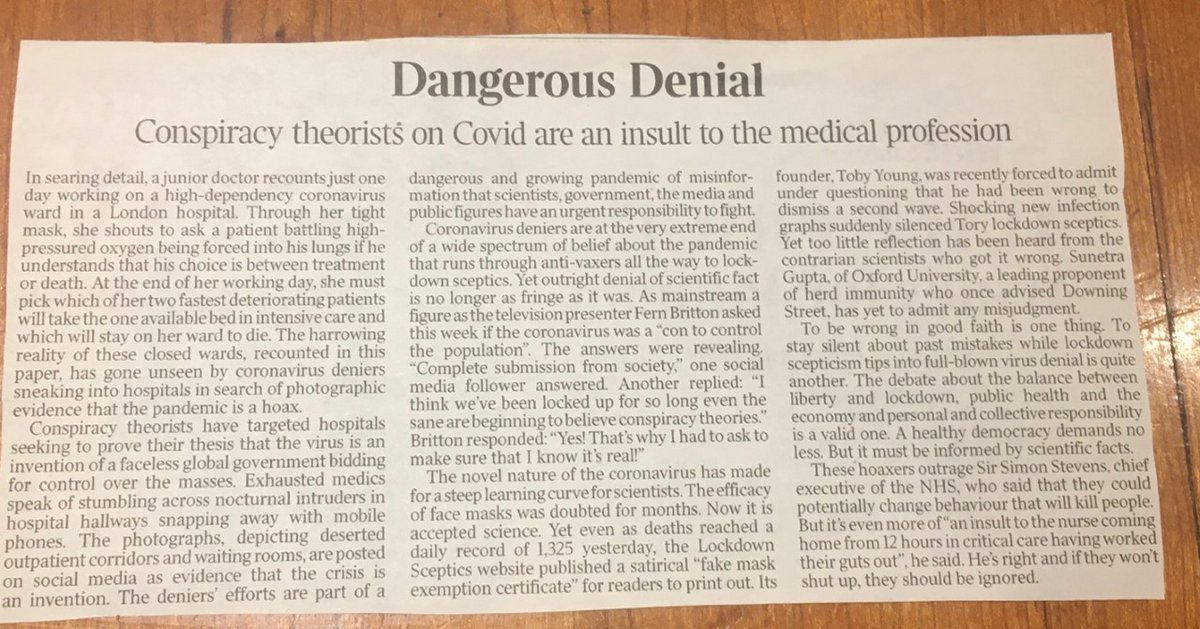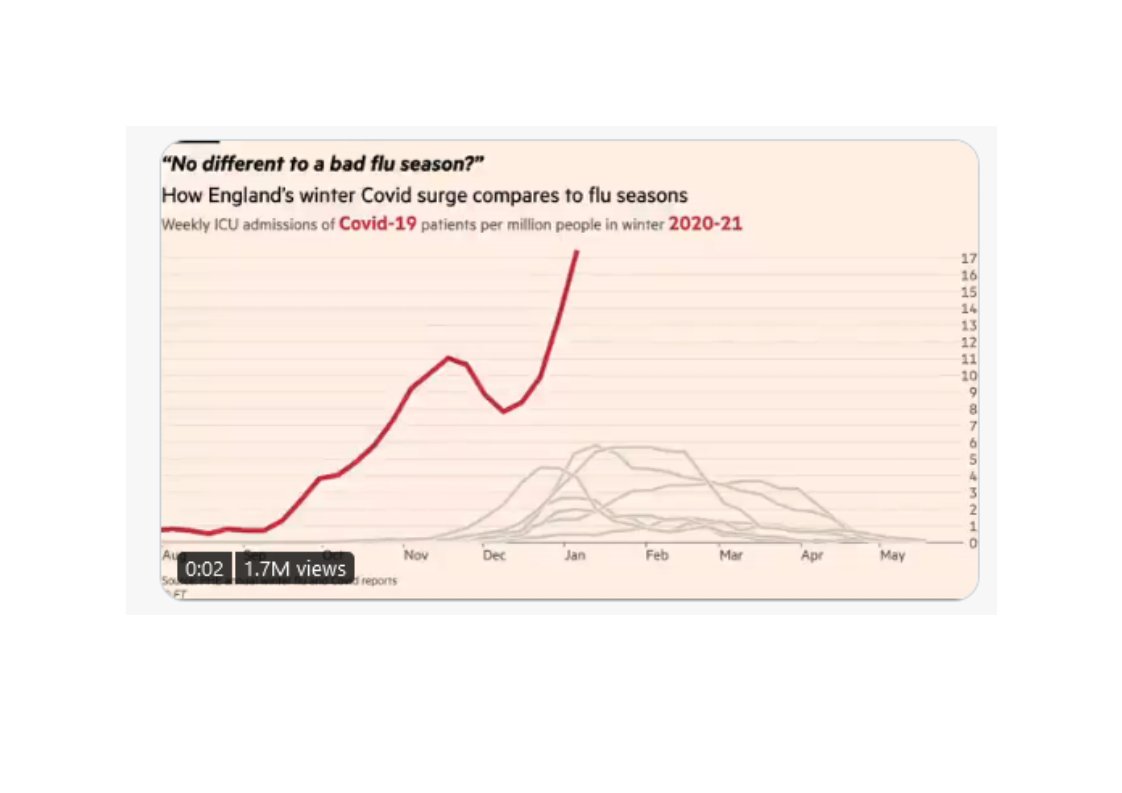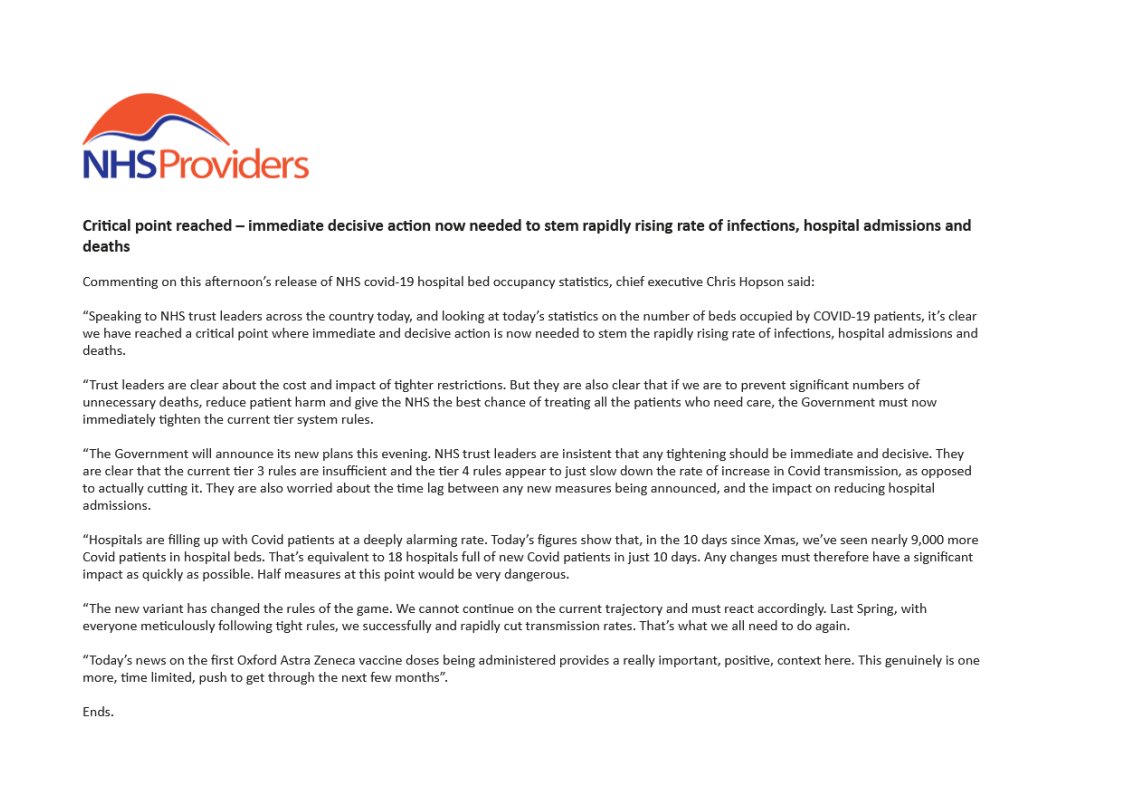
1/20 Government lockdown exit roadmap due next week. NHS trust leaders clear, as they’ve been throughout the pandemic, that we need to be cautious. With a strong focus on data, not dates, they think there are four tests to meet before lifting restrictions. New thread below.
2/20 The four tests to pass are COVID case numbers; NHS capacity; progress of vaccination campaign; and protection against new variants. Spoiler alert – the evidence on all four tests shows that there’s a long way to go before we can relax restrictions safely.
3/20 TEST ONE is that COVID case numbers and the R number must drop significantly so infections don’t surge again as soon as restrictions are eased. There are currently around 9,500 daily cases of COVID but when restrictions were eased last year, they were at 1,000 a day….
4/20 ...When restrictions eased prematurely last summer, infection rates, case numbers and deaths in the North went straight back up again. Key SAGE members also calling for total case numbers in the weekly ONS infection survey to be 50,000 compared to the current 695,000.
5/20 TEST TWO is that NHS capacity needs to return to the levels required to ensure the service can treat all the patients it needs to. We are now past the peak of this wave of the pandemic. But there were still 17,000 COVID-19 patients in English hospitals yesterday…
6/20 ...As a sign of how much capacity the NHS can need to cope with highly contagious strains of COVID-19. On 10 September 2020 the English NHS had less than 600 COVID-19 patients in hospital. But it came perilously close to being overwhelmed just 15 weeks later…
7/20 Intensive Care Units (ICUs) remain under particular pressure. In week to 7 Feb, they were running at 170% capacity compared to this time last year. On 11 February, one in four ICUs had seen increases, rather than decreases, in patient numbers in the previous week…
8/20 ...Patient numbers will drop more slowly compared to the first peak. Thanks to the NHS successfully deploying new treatments, far fewer people are now dying from COVID-19. But the corollary is many more patients needing to stay in hospital, for much longer, than last year...
9/20 ...We chaired a video meeting with 16 CEOs from across country and @NHSEngland discussing current pressures last night. Clear, widespread, view was "managing critical care numbers is a difficult daily battle and on current projections likely to be so for another 4-6 weeks"…
10/20 ...NHS staff exhausted, need to recover and must take leave they have repeatedly delayed. There are also other important priorities for NHS to deliver too. Next five priority groups to be vaccinated at speed. Urgent cases delayed from last few weeks to treat...
11/20 ...We are also still at risk of higher demand due to winter weather. Government needs to take account of all these factors to ensure NHS can cope with any surge in cases that could follow lifting of restrictions. Especially if they want restrictions lifted quickly.
12/20 THIRD TEST is vaccination campaign needs to be sufficiently advanced to provide adequate levels of protection. JCVI clear that 99% of mortality risk only mitigated once the top nine priority groups are vaccinated and immunity built, not just the top four groups...
13/20 ...Latest official estimates show that this milestone will only be reached in mid to late May. For this test, that timescale would be a cautious way to start lifting restrictions. NHS trust leaders are hugely proud of vaccinating 15 million people in10 short weeks but...
14/20 ...90% of COVID infections are in the under 70’s. The current average age of COVID-19 patient in ICUs, many at serious risk of death or long term harm, is 59.5 years. The latest data from Israel – world leaders in the proportion of population vaccinated – concerning....
15/20 ...Hospitalisation rates in vaccinated falling rapidly. But, despite a national lockdown beginning in week of 8 January, hospitalisation rates for those who haven’t been vaccinated have been rising, driven by the highly contagious B.117 strain first discovered in Kent...
16/20 ...Govt will need to set out what level of risk of mortality/harm it accepts. Trust leaders, whose job is to save all lives/avoid all unnecessary patient harm, worried by concepts like ‘acceptable death rates to allow return to normal’ or ‘same death rate as seasonal flu’.
17/20 TEST FOUR is that we must have a robust and effective strategy in place to rapidly identify and control future outbreaks from the variant strains that now pose the greatest threat. Latest potentially dangerous strain identified just yesterday: bbc.co.uk/news/health-56…...
18/20 ....Test & Trace only works effectively at much lower case numbers. It also needs to have capacity and capability to genomically sequence large quantities of tests at pace, alongside effective quarantine & outbreak response strategies. Some way away from this at the moment.
19/20 We have had the debate about when and how quickly to lift restrictions before. Each time those arguing for a rapid relaxation were wrong and we had to reimpose restrictions, losing unnecessary lives and causing unnecessary long term patient harm in the process...
20/20 ...We all want this to be the last national lockdown. But only by passing these four tests can we have reasonable confidence that the virus has been contained and that any future outbreaks can be similarly contained. Blog format of this thread here: nhsproviders.org/news-blogs/blo…
• • •
Missing some Tweet in this thread? You can try to
force a refresh





